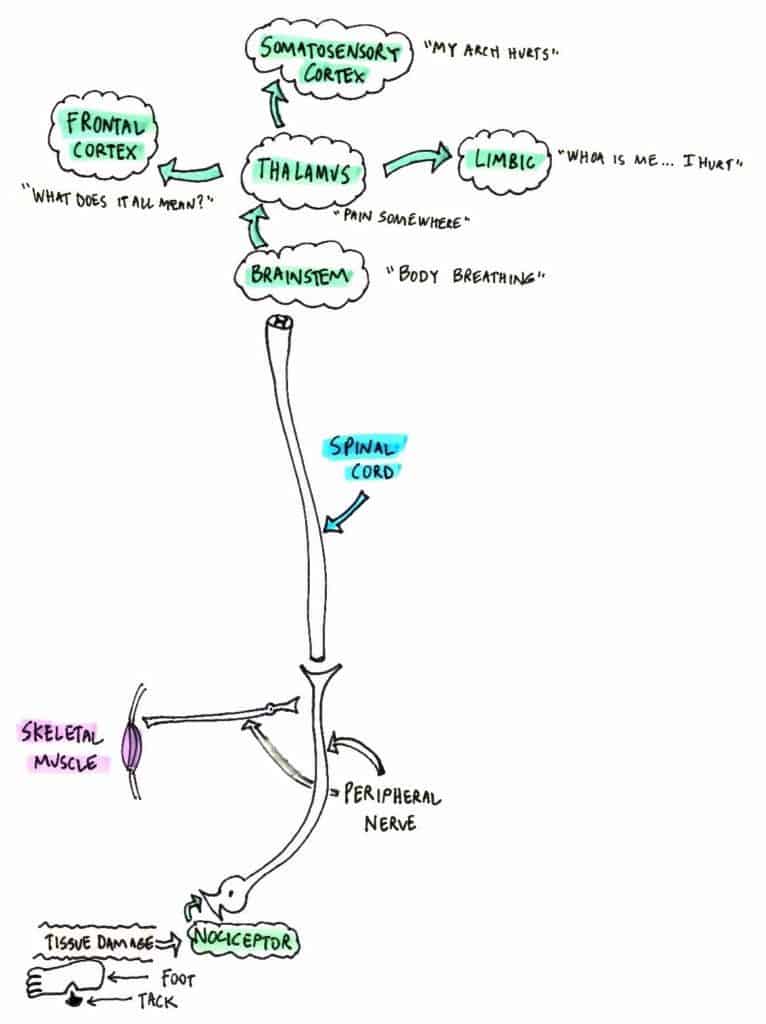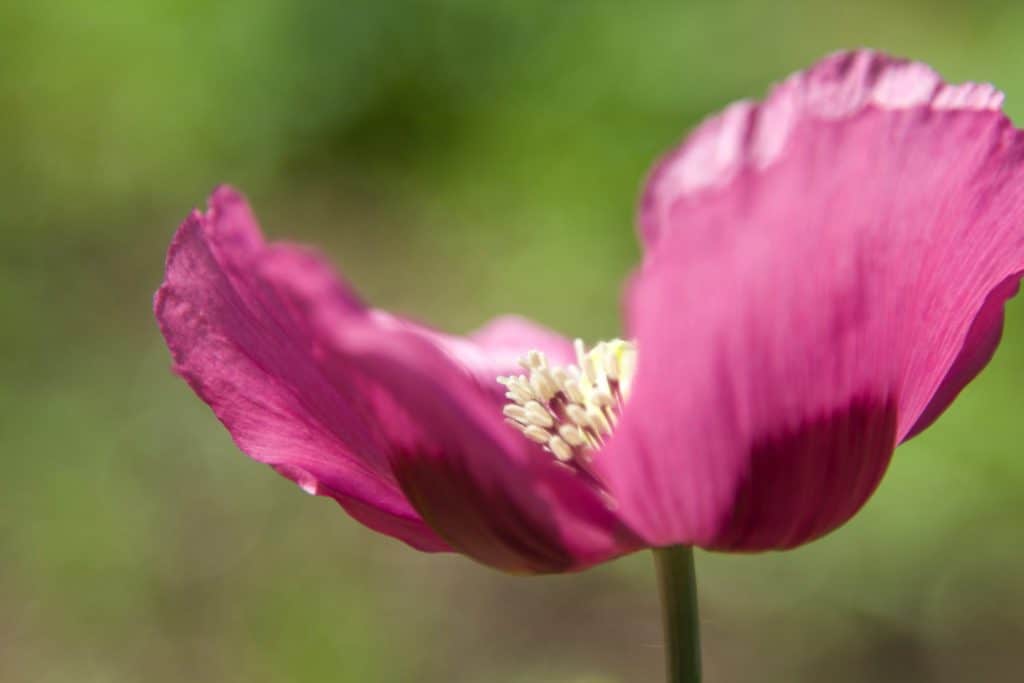“Pain, what is it good for?”…absolutely something
In this country 80 million people and their families suffer from chronic disabling pain syndrome.
$50 billion dollars in lost wages. Over $8 billion per year in pain medications. In over 90% of the cases, there’s no structural impairment causing the pain.
Over 90%.
This post is about different kinds of pain, and I’ve written out 9 things that can help manage chronic pain.
But first… my favorite definition of pain:
“Pain is a biopsychosocial phenomenon of an unpleasant sensory & emotional experience associated with actual or potential tissue damage, or described in terms of such damage.” ~ Judy Foreman
Here’s a drawing to explain how pain works in our bodies.
Here’s a tool bag of techniques for managing chronic pain.
(and make sure to get your symptoms checklist at the end of this post)
Not one thing on this list is going to remove chronic pain. This is meant to be an entire meal to pick from. Each day you may chose one thing over another. Some you may need every day. I encourage you to explore and try them all.
1. Understand how pain works.
A direct electrical pathway connects the site of pain/injury to the area of the brain registering where you are hurting. This pathway has gaps where chemicals cross to carry the pain current all the way up. Pharmaceuticals, acupuncture and herbal interventions interrupt this pathway at some point. Throw a monkey wrench in somewhere and you stop the message. Further study would aid you in knowing where each of the interventions interrupts the pathway.
2. Know which type of chronic pain you have. Nociceptive, Inflammatory, Neuropathic or Dysfunctional.
Acute, nociceptive and inflammatory pain tells us something is wrong and to change our behavior. “Stop doing what you’re doing! You’re hurting yourself!” The other categories of chronic pain aren’t always so straightforward. Sometimes there’s damage being done, like with osteoarthritis and disc degeneration or nerve damage. Sometimes the nerve itself has been damaged and is signaling pain. Sometimes no damage is being done and the body is signaling pain because it has either forgotten how to shut off the pain signal or has rewired itself completely backwards and is amplifying pain in the absence of a stimulus.
Nociceptive (as in noxious) pain is what we know as regular pain. You stub your pinky toe and it hurts. You’ve done some damage. Remove the damage-causing stimulus, let the body heal and the pain goes away. Easier said then done sometimes. Try telling a runner with Achilles tendonitis to stop running to let the body heal or the breadwinner at home to stop going to work for a month to let their low back heal. We can’t always do what nature intended (rest in case you were wondering). Sometimes we need to keep keeping on.
Inflammatory pain is caused by, you guessed it, inflammation. It is appropriate and adaptive in an acute situation. It is inappropriate and maladaptive in a chronic state.
Dysfunctional pain signals pain when NO damage or inflammation has occurred. The nervous system is amplifying or creating pain signals for no apparent good reason.
Neuropathic pain sounds the alarm when the nerve tissue itself has been damaged such as the cases of trauma to the nerves in surgery, pressure on nerve tissue (sciatica or disc herniation), injury from chemotherapy or infection from a virus (herpes zoster, a.k.a. shingles).
3. Manage inflammation
Inflammatory pain is one category of pain. Keeping inflammation at a minimum will help manage the pain. See my blog post for more information,
or
check out my upcoming course on inflammation.
4. Understand what you are taking to manage pain, and if it’s appropriate.
The mechanism of action for the internal interventions folks use cannot be covered in detail here. But we can look at an overview.
In general, NSAIDs (over the counter pain medications such as Advil and Aspirin) work at the level of the nociceptor (pain receptor at site of injury) and anywhere prostaglandins are produced. They stop production of prostaglandins, the inflammation and pain-signaling chemicals. NSAIDs do come with a risk. They are known to cause pin prick holes (or larger) in the gut lining. Ibuprofen causes 16,000 deaths/year and over 100,000 gastrointestinal bleeds/year. I like to say, “they’re not skittles” (not benign little candies). In the realm of herbal medicine, Willow bark works with the same mechanism, but does not cause the holes or bleeding.
Ice at the site of an injury decreases the number of nerve impulses carrying the pain signal.
Capsaicin in Cayenne pepper, and CBD in Cannabis, both act to decrease substance-P, one of the neurotransmitters of the pain impulse.
“Kissing the booboo”, that ancient technique we all know and utilize works by increasing the number of impulses for touch, which, floods the nervous system and doesn’t allow as many “pain” signals to reach the spinal cord. The fancy term is Hyperstimulation Analgesia. (The TENS unit folks use for chronic pain works under the same theory….it just uses electric stimulation instead of touch.)
Opiates work by decreasing substance-P release in the nerves of the brain and spinal cord. No substance-P released, no pain signal transmission. The major issues with opiates are the side effects and risk of addiction. Endorphins are our own body’s opiates. Anything you can do to increase feel good sensations increases pain relieving production of Endorphins. Acupuncture works to increase endorphin production. Cannabis has been found to be as effective as opiates for relief of some types of chronic pain. It has also been proven to increase their effectiveness and decrease the need for opiates by 30%. Cannabis and opiates work together as synergists. Cannabis is 20X stronger than Aspirin and 2X stronger then hydrocortisone.
5. Teach your body to relax.
“My favorite part of yoga class is the nap at the end.” The end of a good yoga asana class has progressive relaxation techniques that train your body to relax. In our high stress, fast paced lives, we need to retrain our body what it means to feel safe and relaxed.
When you practice this technique you actually focus on what is not hurting and your muscles learn to relax. A good resource for this technique is: The Relaxation Response by Herbert Benson
6. Exercise & Rest.
Exercise and mood share the same chemistry.
You literally manufacture feel good chemicals when you exercise. One of them is your very own morphine, Endorphins. The more you do it, the more you make. You also make endorphins when you do something you enjoy.
Rest is ABSOLUTELY CRUCIAL for healing, resiliency and well being. Sleep causes a decrease in Substance-P production. Remember it carries the pain signal in the nerve….keeps it going.
Sleep also increases in Serotonin production. More Serotonin causes a decrease in pain sensitivity. Or to put it another way, the less you sleep, the more sensitive to pain you are.
Managing your mind categories
The last three items in this Pain toolkit are about managing your mind.
Our mind is the most powerful tool we have. It literally can have us feel sensations, including pain, that are not there. Using and learning to manage our mind is a crucial tool to pain management.
And no, I am NOT saying it’s all in your head or it’s your fault or not real.
No way.
(For the record, it is all in your head. If you didn’t have a brain, you would not feel pain… for reals.)
7. Add pleasant activities to your day.
Pleasant activities, where you feel good, increase your endorphins. Play with your grandchildren more. Walk outside. Eat good food. Watch kitten videos (you don’t need a link to find kitten videos).
8. Distraction as a tool.
When you listen to the sound of the waves at the ocean’s edge, in that instant you are not thinking about your pain and you are actually releasing endorphins. An instant of no pain is a relief, is a step of pain management. Build more of them. See how I combined distraction and pleasant activities there?
9. Meditation for pain management.
100’s of studies now confirm that a simple 8-week course on mediation decreases pain. Meditator’s brains, even after 8 weeks, actually change physically.
Let me say that again, your. brain. changes.
Chronic pain is the major cause of lost wages in this country. All of us either know someone or are that someone in chronic pain. Understanding the mechanism of how pain works is one step in a long list of steps to help manage it. The list here is a guideline for techniques that have been proven to work. Try them all and see which ones help you.
For a great, comprehensive resource, check out the book, A Nation in Pain by Judy Foreman.




